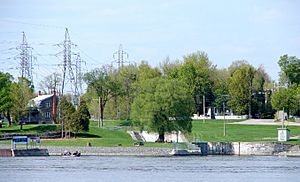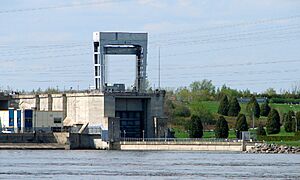Carillon Canal facts for kids
Quick facts for kids Carillon Canal |
|
|---|---|

Downstream entrance of the original Carillon Canal
|
|
| Location | Quebec, Canada |
| Nearest city | Saint-André-d'Argenteuil |
| Built | 1830 |
| Governing body | Parks Canada |
| Website | Official website: http://www.pc.gc.ca/eng/lhn-nhs/qc/canalcarillon/index.aspx |
The Carillon Canal is a special place in Saint-André-d'Argenteuil, Quebec. It's a National Historic Site of Canada because it protects the old Carillon Canal. This canal was first built in the 1830s to make boat travel easier on the Ottawa River.
Today, it's an important historical spot and a fun area for people to visit. About 20,000 pleasure boaters and 30,000 other visitors enjoy the riverside park each year.
Contents
About the Carillon Canal
The Carillon Canal is part of a system of canals. These canals, including the Grenville Canal and the Chute-à-Blondeau Canal, helped boats get around the Long Sault Rapids on the Ottawa River. These rapids were a tricky 21-kilometer (13-mile) stretch from Carillon to Grenville.
Why the Canal Was Built
The idea for these canals came from the War of 1812. During this war, attacks along the Saint Lawrence River made it risky to send messages and supplies between Kingston and Montreal. These were two main military bases in Upper and Lower Canada. So, the Ottawa River Canals and the Rideau Canal were planned as another way to move soldiers and supplies if there was a war with the Americans.
Building the Canal
Work on the Grenville Canal started first in 1818. In 1819, Captain Henry Vernet from the Royal Corps of Engineering came from Britain to lead the project. Hundreds of Irish immigrants and French Canadians dug out the canal. They worked under the guidance of about a hundred British soldiers.
By 1833, the Grenville Canal was finished. It was about 9.5 kilometers (5.9 miles) long. The whole canal network on the Ottawa River, which included 11 locks, was fully completed around 1843.
The military's needs decided how the canal was built. The locks were made 134 feet (41 meters) long, 33 feet (10 meters) wide, and only 5 feet (1.5 meters) deep. These sizes were good for military boats, but not big enough for trade boats.
Changes Over Time
After a while, logging (cutting down trees) became the main business in the area. By 1867, local business people asked the government to improve the canal network. The original canals were becoming too old and small.
In 1870, a group called the Canals Commission suggested making the Ottawa River deeper. So, between 1873 and 1882, the Grenville and Carillon Canals were made bigger. A dam built upstream from Carillon village raised the water level. This meant the Chute-à-Blondeau Canal and lock were no longer needed.
The Carillon Canal was officially named a National Historic Site in 1929.
More big changes happened from 1959 to 1963. The Carillon hydroelectric dam was built, along with a modern 20-meter (66-foot) high lock at Carillon. This work greatly and permanently changed the canal system. The dam raised the water level by over 62 feet (19 meters) at Carillon and over 9 feet (2.7 meters) at Grenville. The new water level flooded the Long-Sault rapids, turning them into calm, still water.
Things to See
Besides the original canal itself, there are other interesting historical things to see:
- The remains of lock No. 1, built between 1830 and 1833.
- The houses where the superintendent (manager) and toll collector lived.
- The jetty (a pier or landing place) of the second canal, built between 1873 and 1882.
- The Carillon Barracks, which now holds the Regional Argenteuil Museum.


